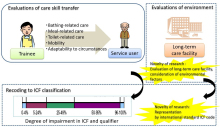ICF-based assessment tool development for care skill training in Japanese long-term care system

November 2017 to February 2019
Lead research institution: University of Hyogo
Other participating research institutions: National Institute of Public Health, Japan; University of Shizuoka; and, Hiroshima University
Principal investigators: Dr Takako Tsutsui, University of Hyogo
Japan
Background
With growing numbers of people living with disability and chronic morbidities, more long-term care professionals are needed to ensure access to quality, cost-effective services. East Asia is already facing a serious shortage of care workers], while in Japan, an additional 380,000 care workers will be needed by 2025 when the post war baby boomers will be 75 years or older. To respond to this growing need, countries are increasing the recruitment and/or training of foreign health workers. For example, in Canada and the United States, foreign health workers represent around one-fifth of the total long-term care workforce.
Japan has received foreign nurses and care workers from Indonesia, the Philippines and Vietnam as part of the Economic Partnership Programme. Recently, the country expanded its Technical Intern Training Programme to include training of foreign health care workers wishing to work in the health care industry in Japan, and exporting Japanese experiences in the field of continuing care as part of its international cooperation programme. With the growth of foreign workers in health care, it is crucial to ensure that training programmes effectively transfer care skills to trainees.
Goal
To develop and validate an evaluation tool based on the International Classification of Functioning, Disability and Health (ICF) to assess the transfer of health care skills in Japan’s Technical Intern Training Programme.
Methods
The new evaluation tool built on existing assessment tools of the Technical Intern Training Programme to incorporate the ICF, and was developed with inputs from a practitioners’ committee of nurses and doctors.
It was pre-tested in selected facilities involved in the Technical Intern Training Programme to identify potential difficulties around comprehension and administration of the evaluation instrument, and to modify the tool accordingly. The tool collected information on the care skill of the trainee, the care requirement of the care receiver, the background of the technical intern, and the employment environment.
The evaluation of whether the care skills had been acquired at the end of the training was determined qualitatively with a sample of trainers. In addition, semi-structured interviews were conducted with facility managers, trainers and foreign trainees for qualitative feedback.
Results
The evaluation tool was field tested in 100 facilities on 300 trainers of foreign technical interns. Most trainers and staff indicated that 38 items covering the four elements of the care skill training system were difficult to use and recommended downsizing the evaluation tool to a maximum of 25 items. Participants suggested a guidebook to clarify the concepts of the ICF and its relevance to the grading of care competencies. Moreover, the heterogeneities in the baseline skill level between the trainees imply that the tool should be sensitive to capture the nuances of how progress is measured from different baseline levels.
Implications
The current project has produced an ICF-based evaluation tool to assess health care skills transfer within Japan’s Technical Intern Training Programme. Since it draws upon the constructs of the WHO ICF, this new tool can potentially be used in other international settings, particularly by countries wishing to employ foreign health care workers. The outcome of this project could have far-reaching implications as the need for health care for older persons, and the reliance on foreign workforce continues to grow, particularly in countries with rapidly ageing populations.

Related PDF downloads:
- Document

